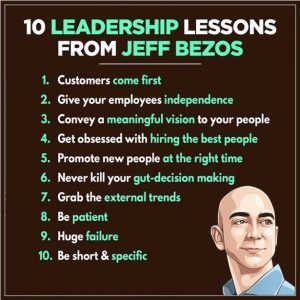Why would anyone want to learn anything from Jeff Bezos? Who is this guy and what makes his leadership lessons of any value? Jeff Bezos is the founder, chairman, CEO and president of Amazon.com, Inc. At the age of 55 (as this is written) he has a reported net worth of just under $165 Billion. For those of us who remember the world before Amazon.com, its introduction and its growth, it’s obvious that whoever was at the helm knew what he was doing. He had a vision and goals and he strategically pursued them. We can assume there were challenges but we can readily see the success.
 When the meme popped up in my Instagram feed with “Ten Leadership Lessons from Jeff Bezos” I thought they might be worth reading and trying to understand. Yes, it is probably the ultimate in arrogance that I even consider myself worthy of adding comment to these ten leadership lessons, but I also feel that a lifetime of learning and experience would qualify almost anyone to do so, provided the observations were relevant and related. These observations can be applied to virtually any company, but most specifically B2B companies.
When the meme popped up in my Instagram feed with “Ten Leadership Lessons from Jeff Bezos” I thought they might be worth reading and trying to understand. Yes, it is probably the ultimate in arrogance that I even consider myself worthy of adding comment to these ten leadership lessons, but I also feel that a lifetime of learning and experience would qualify almost anyone to do so, provided the observations were relevant and related. These observations can be applied to virtually any company, but most specifically B2B companies.
Let’s take a look at the ten lessons and see if we can relate to them, learn from them, apply them in some way to improve our pursuit of business success. Know up front that we have no way of knowing if these are prioritized in any way. They are presented as a numbered list but is #3 more important than #6? It’s my belief that each of these lessons is valuable by itself but some of them also seem to compound on a previously listed one. We’ll discuss that as we go.
Lesson #1: Customers come first
For anyone in the “B2C” – or Business to Consumer – market, this is an obvious statement. The customer comes first. You need the customer to buy your products so you have to make it as easy and valuable to them to do so as is possible while protecting your profit margins. However, if you’re a “B2B” – Business to Business – based operation, identifying the “customer” can get… foggy. The customer could be the person who is reading the information you provide; or the customer could be the advertiser that generates your revenue by paying for advertising and providing information to be disseminated. The advertisers’ needs and interests obviously have to be served to keep the revenue stream flowing, but the information provided has to be valid and of interest to the readership or ultimately the advertising will never be seen. The challenges arise when what the advertisers want differs from what the readers are interested in, or what best serves their interests. Our challenge, I believe, is the on-going balancing act of keeping the advertisers happy (keeping the revenue flowing) while providing what the readership is interested in (delivering our product). It seems counter-intuitive, but our product (to my way of thinking) is not advertising even though that’s what we sell. Our product is information distribution that the advertising revenue ultimately pays for. If that’s true, the “Customers come first” means we have to always keep the information delivery prioritized.
Lesson #2: Give your employees independence
This would seem a no-brainer for a company with as many remotely-located employees as we have. But independence isn’t just working without your boss looking over your shoulder; it’s not just being alone in your home office. It is also the existence of an operational reality that leaves the employee free to perform their job function without having to worry about micro-management from their chain of command or dependence thereon. That said, one part of giving your employees independence is providing them the tools they need to do their job as you require it of them. Failing to provide them the necessary tools virtually insures that they will be dependent on you for assistance, support, services, etc. To empower your employees you have to provide them a fully equipped work environment and then support them to maintain it.
 One BIG danger of not providing for the employee’s work needs 100% is the slippery slope that follows. If your employees need A, B, C, D, E, F, G & H but you’ve got a few that you don’t give F to… and they make do. Then pretty soon you’ll believe that none of them needs F. A few weeks or months go by and then a few of them don’t get D, but it’s okay because they keep functioning. Pretty soon none of them are getting D. Now you’ve got employees with eight work function needs but you’re only providing six of them and look how much you’ve saved the company! Added profit margin is good. Except that the offset “cost” is the employee who is getting disgruntled because the company is demanding the same performance for the same pay but which is providing fewer tools to do the required job.
One BIG danger of not providing for the employee’s work needs 100% is the slippery slope that follows. If your employees need A, B, C, D, E, F, G & H but you’ve got a few that you don’t give F to… and they make do. Then pretty soon you’ll believe that none of them needs F. A few weeks or months go by and then a few of them don’t get D, but it’s okay because they keep functioning. Pretty soon none of them are getting D. Now you’ve got employees with eight work function needs but you’re only providing six of them and look how much you’ve saved the company! Added profit margin is good. Except that the offset “cost” is the employee who is getting disgruntled because the company is demanding the same performance for the same pay but which is providing fewer tools to do the required job.
THAT reality eventually will hurt the company both in overall employee performance, employee retention and employee morale. There’s an old joke phrase that is common in some parts of the military. It’s not something that is funny when you think about it and you NEVER want someone to feel this way about working for you:
We have done so much with so little for so long that we are now capable of doing anything with nothing.
It’s funny… but it’s not. If that ever becomes the reality for any portion of your employees, your company will eventually suffer a work / production deficiency as a result. Guard against that.
Lesson #3: Convey a meaningful vision to your people
Hmm… this one can be a challenge. When you have a company that serves so many different interests, having a single vision to share might be difficult. The bigger challenge is that if you don’t have a message to convey, then one gets assumed. The one that gets assumed is that the company’s vision is to make money. Now, let’s be honest: the purpose of every commercial company is to make money, but if your company has no ethos, no culture, no vision or mission beyond making money, respect will soon be in short supply.
If money is the only goal then greed is assumed to be the only ethic. Ultimately that breeds a work environment lacking in respect and short on motivation. A clear vision statement should be published and republished on a regular basis. It should be prominently displayed on company materials not only so the customers and advertisers can see what the company considers of ethical value, but also so the employees are reminded that they aren’t just driving profit for the company; that there’s a larger purpose; a bigger goal.
Lesson #4: Get obsessed with hiring the best people
This is a great leadership lesson. In business, all too often, the person hired to fill a slot is the person who can acceptably do the job for the lowest pay and benefits. That isn’t the person who is going to have the highest levels of motivation, creativity, drive, career aspirations and more. The “lowest cost hire” is going to be the person who works as if they’re being paid an hourly rate, and if, God forbid, they are hired to work at a salaried rate, then their work ethic will show that. They’ll do the bare minimums of their job, spending as little time as possible, thereby making their salary equivalent to the highest hourly rate they can. The danger of hiring like this is that you not only condemn your company to mediocre work results from the work pool but you also prohibit accomplishing Lesson #2 (Give your employees independence).
If your employees are constantly trying to do the bare minimum to keep the paycheck flowing then you can’t really give them independence. The goal should be to hire the absolute best person for a given position; the person you can feel good about adding to your team and then getting out of their way. That is the person you can trust to take their job and run with it in such a fashion that they are soon accomplishing things you hadn’t even realized were possible or thought about doing. One thing is for sure: the company will not benefit from hiring the only person willing to work for what the company is offering as pay. That isn’t a business practice that invites the best to join your team. That’s a business practice that leaves you with limited selection and employees seeking only to “get in the door” so they can see where else they can go or what they can learn… so they can then take those skills elsewhere. Having only ONE option isn’t an option.
The other side of this: The phrase, “He who does more than he is paid for will soon be paid for more than what he does,” is true. The employee who is hired for minimal pay has to be a truly special person to do more than their job. If you are paying so little that you only have one person willing to take the job, it’s not likely they are the person will to do more than required. People will to do more than they’re paid for also know their worth and won’t work for those unwilling to pay that worth.
Lesson #5: Promote new people at the right time
Growth is important for we humans. We thrive on feeling like we’re growing and improving. We dislike being stagnant. Stagnation breeds boredom and boredom is a contributor to depression. New tasks, new accomplishments, new knowledge and new skills – these are all things that add value to our days. Ultimately, if a person has no hope or expectation of growth then they will seek out someplace where growth and improvement is possible.
By the nature of some positions limited growth is all that exists. In those situations, it would benefit the company to offer training or incentives for training the employee pursues elsewhere, so that promotion eventually becomes possible. If nothing else, the employee would still feel improvement through the on-going growth of training. If promotions are possible, then promoting the right person at the right time is of obvious value to all involved. The employee benefits from the promotion and the company benefits from a motivated growing (in skill sets and knowledge) employee.
This is a similar outlook as displayed in this short dialogue:
The CFO asks a question of the CEO, “What if we pay for training and the employee takes it and leaves?”
To which the CEO replies. “What if we don’t and they stay?”
Which situation would you prefer?
Lesson #6: Never kill your gut-decision making
Entire research papers have been written about intuition and the power of non-conscious decision making. The challenge comes in when the obvious business-smart decision is also counter-intuitive. Say that a different way: the intuitive decision is sometimes counter-business-smart. But just because it SEEMS like a bad business decision doesn’t mean it ultimately is. Trust your gut sometimes. Sometimes mistakes will get made. Sometimes the mistakes will cost you (see Lesson #9 below), but ultimately, if you always only do the business-smart thing you’ll end up missing out on opportunities and making mistakes. We humans have intuition for a reason. You have to trust yours.
Elan Musk (another reasonably successful business guy): If you’re not making mistakes you’re not trying hard enough to innovate.
Accept that mistakes will get made but don’t let them result from missing opportunities because you failed to trust your gut instincts.
Lesson #7: Grab the external trends
I have to believe that even Jeff Bezos looks around at what other successful businesses are doing and tries to identify what he can replicate to his company’s benefit. Inevitably that type of examination will lead you to identify what others are doing that you’re not. Do you then incorporate those practices?
It is an unfortunate reality that some of our competitors are doing things that we thought about doing years ago but didn’t pursue because, in those instances, we would have been the trend-setters instead of following a trend. We would have been investing time and funds toward an untried, unproven strategy. It’s a shame we didn’t take that risk because our competitors have been monetizing it for years and now it has become a trend. The only thing better than grabbing the external trends is being part of what starts the trend. Setting the trends – or even being capable of it – requires compliance with Lessons #3 and #4 above.
Lesson #8: Be patient
Growth and success are aggressive, right? Not necessarily. Sometimes the best success comes from patience and consistency. In a world full of 15-second video clips and people who get rich from a one-minute Youtube segment, it’s almost reasonable to desire and expect quick success. The down side of that approach is that if the success doesn’t come fast, too many people (and companies) cut their losses and quit. They go start somewhere else and do the same thing: search for quick success and, not finding it, quit again. I submit to you that you can’t have success without facing challenges and it takes tenacity and persistence to get through challenges to the other side where success is possible. Patience is required to see the results of your tenacity and persistence.
Lesson #9: Huge failure
I feel like this ought to say “hug failure.” Failure must be embraced if success is to be earned. I am a big believer in the statement that you haven’t failed until you’ve quit. If you learn something from failing to accomplish a goal then that experience makes all the difference. The next time you make an attempt you’ll know what NOT to do. If you learned, was it really a failure? Instead of running from failure, perhaps it’s better to pursue success so doggedly that every failure becomes a valued lesson to be leveraged and appreciated.
Lesson #10: Be short & specific
Something I obviously don’t know how to do, but I’ll keep practicing. Brevity is a good thing.
Conclusion
Here’s the challenge from an arrogant employee: go back and read those lessons again and see which ones we’re NOT doing right. Can we fix them?
